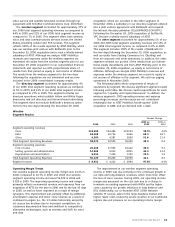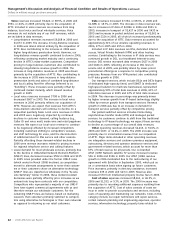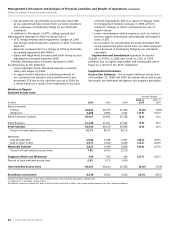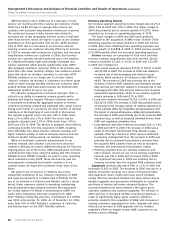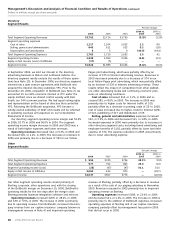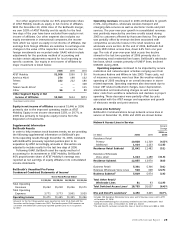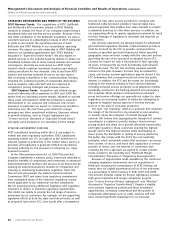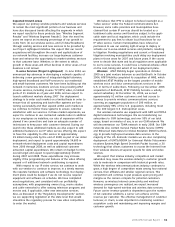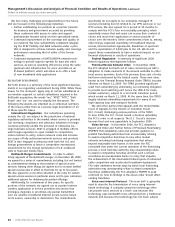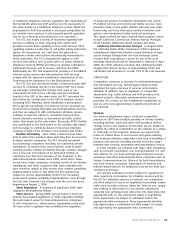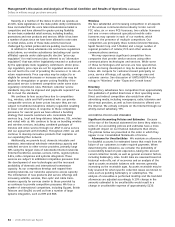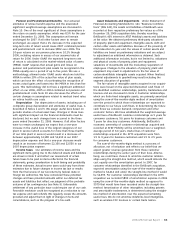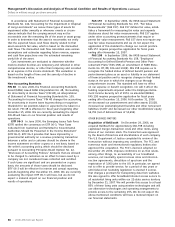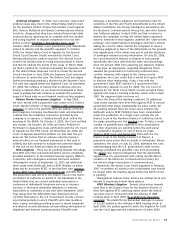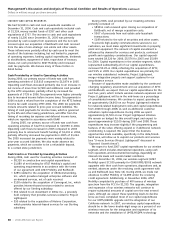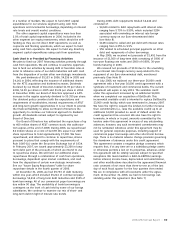AT&T Wireless 2006 Annual Report Download - page 33
Download and view the complete annual report
Please find page 33 of the 2006 AT&T Wireless annual report below. You can navigate through the pages in the report by either clicking on the pages listed below, or by using the keyword search tool below to find specific information within the annual report.
2006 AT&T Annual Report : :
31
Expected Growth Areas
We expect our primary wireline products and wireless services
to remain the most significant portion of our business and
have also discussed trends affecting the segments in which
we report results for these products (see “Wireline Segment
Results” and “Wireless Segment Results”). Over the next few
years we expect an increasing percentage of our growth to
come from: (1) our wireless service, and (2) data/broadband,
through existing services and new services to be provided by
our Project Lightspeed initiative. We expect that our recent
acquisitions will strengthen the reach and sophistication of
our network facilities, increase our large-business customer
base and enhance the opportunity to market wireless services
to that customer base. Whether, or the extent to which,
growth in these areas will offset declines in other areas of our
business is not known.
U-verse Services (Project Lightspeed) In June 2004, we
announced key advances in developing a network capable of
delivering a new generation of integrated digital television,
high-speed broadband and VoIP services to our residential
and small-business customers. We have been building out this
network in numerous locations and are now providing AT&T
U-verse services, including U-verse TV (IPTV) video, in limited
parts of 11 markets as of year-end 2006, and we expect to
launch additional markets during 2007. Our deployment
strategy is to enter each market on a limited basis in order to
ensure that all operating and back-office systems are func-
tioning successfully and then expand within each market as
we continue to monitor these systems to ensure customer
satisfaction with our services. In these market expansions, we
expect to continue to use contracted outside labor in addition
to our employees as installers; our rate of expansion will be
slowed if we cannot hire and train an adequate number of
technicians to keep pace with customer demand. During our
launch into these additional markets, we also expect to add
additional features to our IP video service offering. We expect
to have the capability to offer service to approximately
19 million living units by the end of 2008, as part of our initial
deployment, and expect to spend approximately $4,600 in
network-related deployment costs and capital expenditures
from 2006 through 2008, as well as additional customer
activation capital expenditures. We remain on budget for this
overall target and expect to spend approximately $3,100
during 2007 and 2008. These expenditures may increase
slightly if the programming and features of the video offering
expand or if additional network conditioning is required.
With respect to our IP video service, we continue to work
with our vendors to continue to improve, in a timely manner,
the requisite hardware and software technology. Our deploy-
ment plans could be delayed if we do not receive required
equipment and software on schedule. We have completed
most negotiations, and consistent with our profitability
assumptions, with programming owners (e.g., movie studios
and cable networks) to offer existing television programs and
movies and, if applicable, other new interactive services.
Also, as discussed in the “Regulatory Developments” section,
we are supporting legislation at the state level that would
streamline the regulatory process for new video competitors
to enter the market.
We believe that IPTV is subject to federal oversight as a
“video service” under the Federal Communications Act.
However, some cable providers and municipalities have
claimed that certain IP services should be treated as a
traditional cable service and therefore subject to the appli-
cable state and local regulation, which could include the
requirement to pay fees to obtain local franchises for our
IP video service. Certain municipalities have refused us
permission to use our existing right-of-ways to deploy or
activate our U-verse-related services and products, resulting
in litigation. Pending negotiations and current or threatened
litigation involving municipalities could delay our deployment
plans in those areas for 2007 and future years. If the courts
were to decide that state and local regulation were applicable
to our U-verse services, it could have a material adverse effect
on the cost, timing and extent of our deployment plans.
Wireless AT&T Mobility began operations in October
2000 as a joint venture between us and BellSouth. In October
2004, AT&T Mobility completed its acquisition of AWE, which
established AT&T Mobility as the largest provider of mobile
wireless voice and data communications services in the
U.S. in terms of subscribers. Following our December 2006
acquisition of BellSouth, AT&T Mobility became a wholly-
owned subsidiary. At December 31, 2006, we served
approximately 61 million customers and had access to
licenses to provide wireless communications services
covering an aggregate population of 296 million, or
approximately 99% of the U.S. population, including most
of the 100 largest U.S. metropolitan areas.
Our wireless networks use equipment with GSM and TDMA
digital transmission technologies. We are transitioning our
subscribers to GSM technology, and over 99% of our total
usage, based on minutes of use, is on our GSM network. We
will decommission our TDMA network in early 2008. Our GSM
networks also contain General Packet Radio Service (GPRS)
and Enhanced Data Rates for Global Evolution (EDGE) technol-
ogy to provide high-speed wireless data services. In the
majority of the U.S. domestic markets we are also completing
deployment of UMTS/HSDPA (or Universal Mobile Telecommu-
nications System/High Speed Downlink Packet Access), a 3G
technology that allows customers to access the Internet from
their wireless devices at superior speeds for data and video
services.
We expect that intense industry competition and market
saturation may cause the wireless industry’s customer growth
rate to moderate in comparison with historical growth rates.
While the wireless telecommunications industry continues to
grow, a high degree of competition exists among four national
carriers, their affiliates and smaller regional carriers. This
competition will continue to put pressure upon pricing and
margins as the carriers compete for potential customers.
However, as wireless Internet connectivity and wireline/
wireless convergence are realized, we expect increased
demand for high-speed wireless and wireless data services.
Future carrier revenue growth is dependent upon the number
of net customer additions a carrier can achieve and the
revenue per customer. The effective management of customer
turnover, or churn, is also important in minimizing customer
acquisition costs and maintaining and improving margins and
customer growth.


